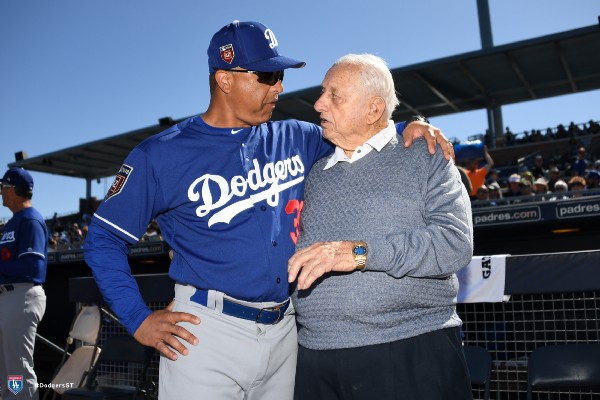While Spring Training is a time for obsessing who will be on the Dodgers’ 25-man roster on Opening Day, Opening Day itself begins a season’s worth of mania over who bats where in the Dodger starting lineup.
Most angst over batting order is overblown. David Pinto annually runs an analysis on lineups at Baseball Musings, and in his post this week about the Dodgers, he found the difference between the best and worst lineup using projected Dodger regulars was barely half a run per game. That’s not nothing, but it’s hardly everything.
Consider that even in a lineup with the pitcher batting leadoff, the Dodgers would project to average 4.5 runs per game (click to enlarge).
Then, when you look at the specifics, you might find the waters even muddier. Joc Pederson, who if he plays (a big question mark right now) would seem to be ticketed for the lower third of the lineup, bats third in the most productive Dodger batting orders that include him.
Stereotypically, the No. 3 slot is reserved for the lineup’s best hitter, not one of its weakest. But here’s how Pinto explained it.
“With the pitcher batting eighth, the third slot is less important,” Pinto wrote on Twitter. “In general, with a good OBP in the ninth slot, 1, 2 and 4 are where you want your best players.
“There are two offensive sequences. 9-1-2-3, and 4-5-6-7, with the eighth slot for the weakest hitter on the team,” he added. “Four is the swing man. He drives in the top sequence with power, then sets up the bottom sequence with OBP.”
Essentially, I would say you begin constructing your lineup with the idea that you want your best on-base hitter to lead off, because that way he’ll get the most plate appearances. But because you don’t want your top OBP guy to bat after the pitcher’s spot once the lineup turns over, you put an actual hitter in the No. 9 slot. And then the dominoes begin to fall.
That still wouldn’t make me inclined to, for example, put Pederson ahead of Bellinger in the batting order, but apparently the math says to do just that.
Keep in mind, though, that the lineups above were generated from 2018 projections, which in this case were somewhat bearish on Chris Taylor, to the point where he and Pederson were nearly identical. Plus, of course, this doesn’t take into account platoon scenarios and all the other factors that influence a batting order.
My point with this post is twofold:
- Don’t obsess over batting order.
- If you must obsess over batting order, don’t assume that what’s traditional is what’s correct.
Beyond that, I leave you with this thought from Pinto:
“Note that Yasmani Grandal brings up the rear with a .327 projected OBP,” Pinto wrote. “If that’s the lower end of the scale, the Dodgers are going to have tons of runners on base, and tons of runners tend to lead to tons of runs.”







Comments are closed.